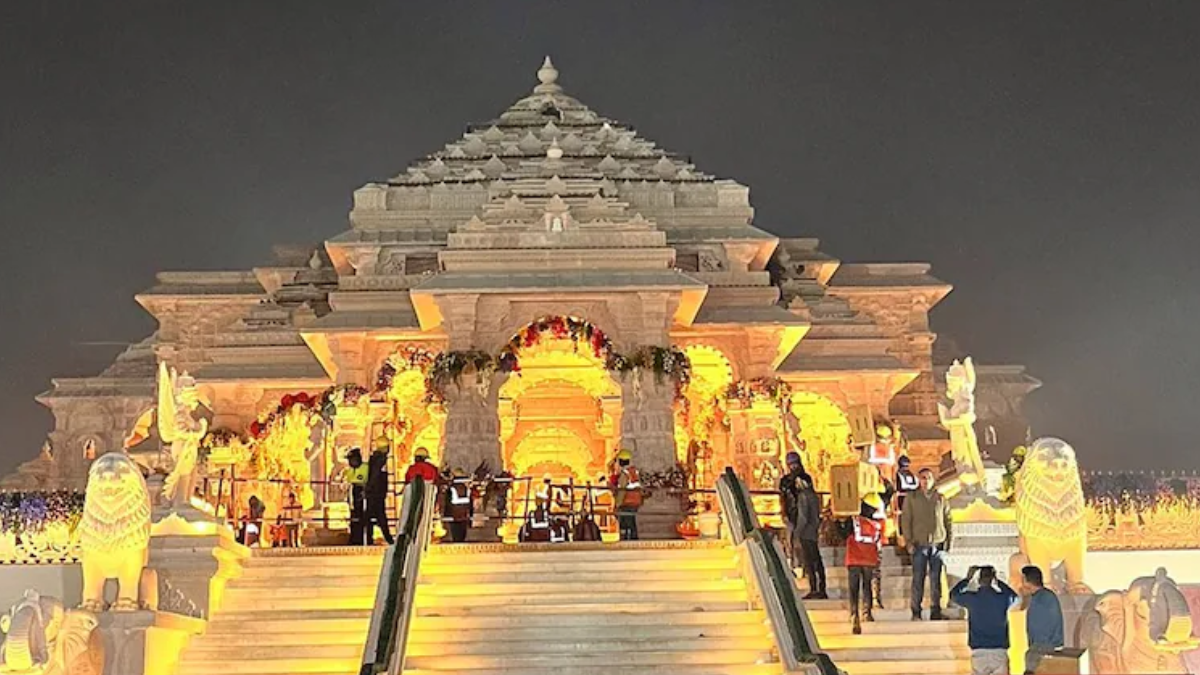
Ayodhya is preparing for a historic moment in the Ram Mandir's legacy as Prime Minister Narendra Modi will be hoisting a saffron flag on the spire of the Ram Mandir, marking its completion. Earlier, PM Modi and RSS Chief Mohan Bhagwat offered prayers to Ram Lalla in Ayodhya.
Years after the grand inauguration of the Ram Mandir, the city draws devotees from across India and abroad.
The central highlight of the ceremony, known as 'Dhwajarohan', is the tall 191-foot saffron flag that will be raised on the top of the temple's main Shikhara (spire). This flag is a symbol of dharma, devotion, and the eternal presence of Bhagwan Shri Ram.
The special ceremony will be held on Tuesday, November 25, 2025, an auspicious date aligning with other important dates on the Hindu calendar, such as Margashirsha Shukla Panchami, Vivah Panchami, and the martyrdom day of Guru Tegh Bahadur.
The shubh muhurat (auspicious timing) for the flag hoisting is between 11:52 am and 12:35 pm, with the main ritual to be completed within a four-minute window inside that duration. The timing has been opted for carefully to ensure the ceremony will take place under the most auspicious time.
#WATCH | Ayodhya Dhwajarohan | PM Modi and Sarsanghchalak Mohan Bhagwat offer prayers at Darshan and Pooja at Shri Ram Darbar Garbh Grah amid Vedic Manta Chants ahead of the historic flag hoisting at Shri Ram Jamnabhoomi Temple
— ANI (@ANI) November 25, 2025
(Source: DD) pic.twitter.com/2emhTS61ja
Ahead of the flag hoisting by PM Modi, here are seven lesser-known facts about the temple.
Following ancient construction practices to ensure that the structure would last very long, not a single gram of steel or iron was used in its construction. This is because iron corrodes easily and generally has an average life of 80-90 years. The main materials preferred for the construction were Bansi Paharpur pink sandstone, granite, and white Makrana marble, in order to ensure that it lasts for at least 1,000 years.
Don't miss: What's Inside Ram Mandir Inauguration Invite
The temple incorporates an innovative, low-maintenance mechanical system that requires no electricity or battery to operate. On the day of Ram Navami (Lord Ram's birth anniversary), a precise arrangement of mirrors and lenses channels the sun's rays to focus directly onto the forehead of the Ram Lalla idol for a few minutes at noon, symbolically anointing the deity.
The temple's foundation itself carries a lot of spiritual meaning. Sanctified soil from 2,587 regions across India, including notable holy places like Jhansi, Bithoori, and the Golden Temple, was brought in to build the foundation. Besides this, water from more than 150 holy rivers across India was also used in the construction rituals.
A time capsule has been buried about 2,000 feet below the temple. This capsule is designed to contain a copper plate inscribed with messages pertaining to Ram Mandir, Lord Ram, and Ayodhya. In this way, the identity, history, and cultural importance of the temple can be preserved for future generations in case of any big historical upheaval.
The construction is primarily a traditional lock and key mechanism that interlinks the carved stone blocks used in its construction, rather than any conventional cement or lime mortar. This method of interlocking continues to ensure structural integrity and longevity, again harking back to ancient Indian temple building styles.
VIDEO | Ayodhya: PM Modi (@narendramodi) offers prayers at the Sapt Mandapam inside the premises of the Shri Ram Janmabhoomi Temple.
— Press Trust of India (@PTI_News) November 25, 2025
(Source: Third Party)
(Full video available on PTI Videos – https://t.co/n147TvrpG7) pic.twitter.com/uFFYiTcQuE
The Ram Mandir has been designed by the famous Sompura family of Ahmedabad, led by chief architect Chandrakant Sompura. This family has designed and built temples for at least 15 generations, including the famous Somnath Temple. Their expertise in the traditional Nagara style of architecture assures authenticity and adherence to Shilpa Shastras.
A special gift of the sacred soil from Thailand, which is a token and a gesture for international spiritual camaraderie and a tribute to the perpetuation of Lord Ram's legacy beyond borders, was sent and inducted into the consecration ceremony. This underlines the deep connections the epic Ramayana has with many South East Asian countries.
Image courtesy: Instagram
For more such stories, stay tuned to HerZindagi.
Also watch this video
Herzindagi video
Our aim is to provide accurate, safe and expert verified information through our articles and social media handles. The remedies, advice and tips mentioned here are for general information only. Please consult your expert before trying any kind of health, beauty, life hacks or astrology related tips. For any feedback or complaint, contact us at compliant_gro@jagrannewmedia.com.